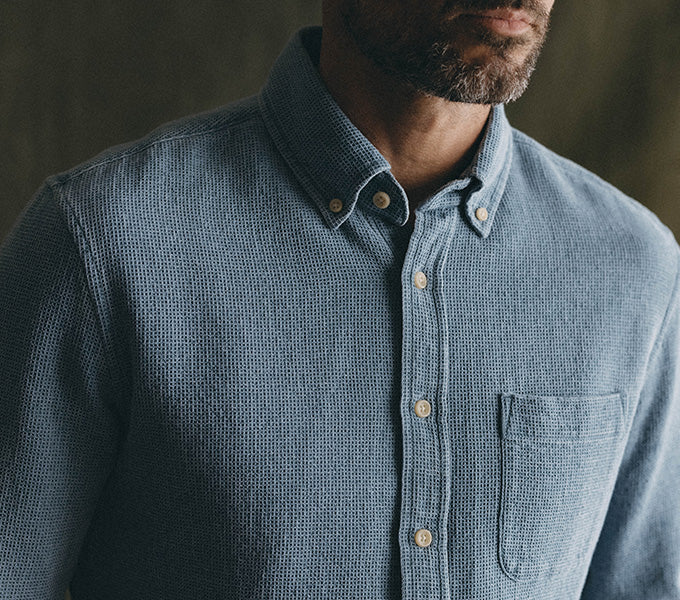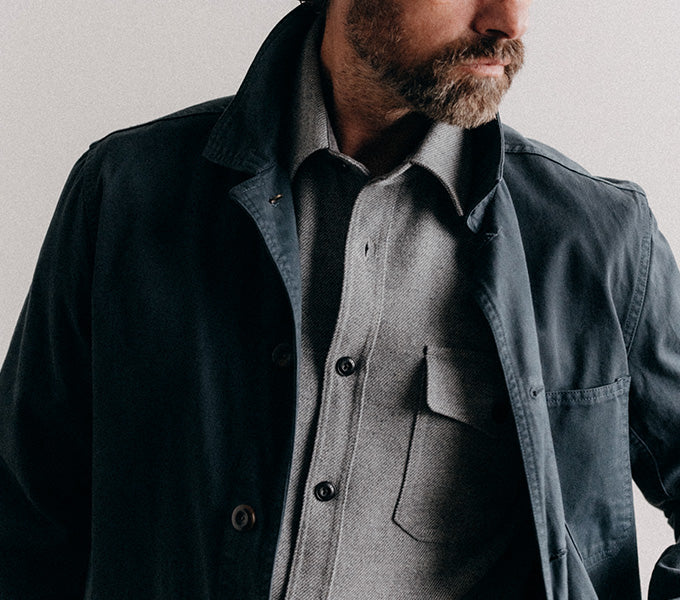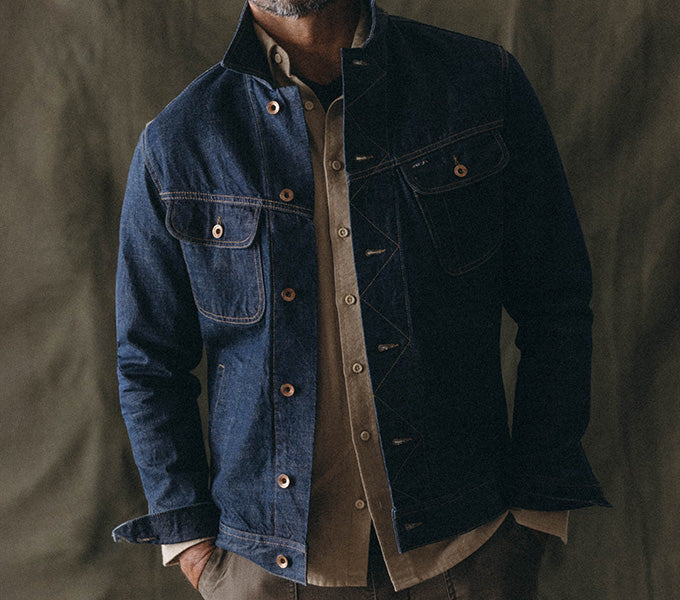From the humble workman’s pant of the 1950s to full fledged fashion icon, jeans have come a long way over the years, and with their super versatile looks and legendary longevity, it’s no wonder why. But for someone new to the space, the world of craft denim can be a bit overwhelming; raw denim, selvedge denim, whiskering? The denim-head culture is rife with esoteric lingo and differing opinions, so we’ve put together a handy guide to help you navigate the wild world of denim: going over proper care, washing, and everything in between.
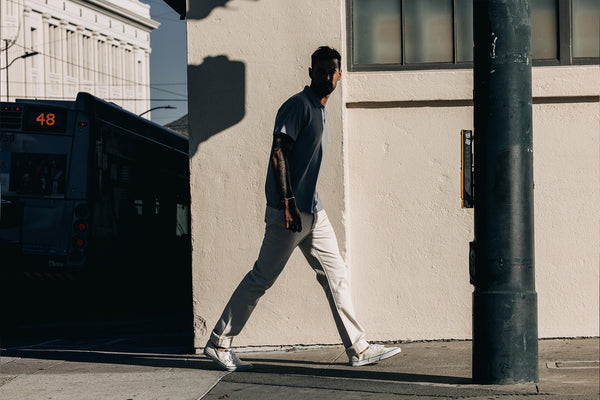
Raw Denim vs. Selvedge Denim
If you’re new to denim and hear these terms thrown around a lot, the distinction can seem fuzzy at best, but it’s actually pretty simple. Raw denim refers to unwashed, untreated denim. Basically, it goes straight from the loom to you. This means that the indigo might bleed as there’s been no washing process to set the indigo and rinse out any excess, and that you can expect your jeans to shrink a bit after their first soak. Denim in its raw state also provides the best potential for high-contrast fades over time, resulting in a pair of jeans totally unique to you and molded to your body shape. If you’ve ever heard the term “shrink to fit,” they’re talking about raw denim.
Selvedge (an evolution of the term “self-edge”) refers to denim that is built on old-school shuttle looms, passing the weft yarns (the crosswise yarns as opposed to lengthwise warp yarns) over themselves at the edge of the fabric rather than cutting them, creating a stronger “self-edge” that resists tears and fraying. You can usually tell a pair of selvedge jeans by their “selvedge ID,” a ticker woven over the edge of the denim that can be made visible by cuffing the hem of your jeans and is often present on the fifth pocket. The color of this ticker used to indicate the mill that produced it, but these days with so many denim producers out there, the color is usually a brand preference.
An important distinction to make is that these terms are not mutually exclusive. There are raw denim jeans out there that aren’t selvedge and plenty of selvedge denim that isn’t raw. Check out our guide to selvedge denim for a deeper dive.
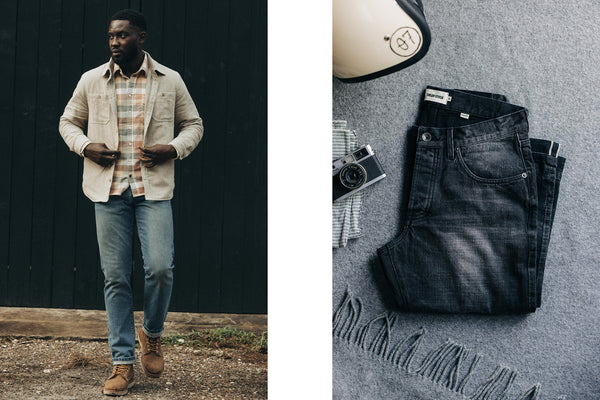
To Wash Or Not To Wash
When Should I Wash My Raw Or Selvedge Denim?
The answer to when you should wash your jeans is far from cut and dry. At the end of the day, when and how often you decide to wash your jeans is a matter of personal preference, dependent upon what kind of look you’re trying to achieve. Washing your jeans less frequently will help your denim hang on to more indigo, resulting in stark, high-contrast whiskering (the faded striations radiating from crotch to outer thigh) and honeycombing (the honeycomb-shaped fades behind your knees).
If you’d rather a more even, softer look to your fades then by all means, wash your jeans more frequently. But be aware, you don’t need to wash your jeans after every wear like other garments. To ensure longevity, we recommend washing every 3-4 months of moderate wear. Ultimately however, when they're washed will depend upon what look you’re trying to achieve.
But please, if your jeans stink… wash them!
How To Wash Raw Denim
While any washing will change the look and fit of raw denim, you can minimize this by keeping it gentle and letting your jeans air dry. If your raw denim is new and your goal is just to minimize indigo bleed and help the dye set then a simple soak in cool water will suffice. If you’ve had your jeans for a while and are dealing with oil and grime buildup, add a small amount of gentle cleaner (one that doesn’t contain bleach) and submerge them in lukewarm water. Allow the jeans to soak for at least an hour, agitating gently every fifteen minutes or so, then rinse them repeatedly until no trace of cleaner remains. Finally, hang to dry.
How To Wash Selvedge Denim
Selvedge denim is a little more forgiving as it has already been washed and is less susceptible to shrinkage, but there are still a few best practices to consider. First off, the same guidelines regarding fades apply: for softer, more even fading, wash as often as every few months. For more striking fades, wash as little as possible. Similarly, selvedge denim can be machine washed according to the care tag, but if you want to hold on to more of that indigo we would still recommend hand washing in lukewarm water with a gentle cleaner. Whichever method you choose, be sure to rinse all the cleaner out of your jeans before hanging them up to dry.

How To Clean Jeans Without Washing
There are a few myths that need to be laid to rest around washing alternatives for cleaning your jeans. Firstly, keeping your jeans in the freezer doesn’t do a darn thing. The idea behind this particular denim myth is that the low temperatures will kill odor causing bacteria, but unfortunately many bacteria can easily survive freezing temperatures and as soon as your jeans reach room temperature again all it takes is one surviving bacteria to repopulate the garment. So guys, take your jeans out of the freezer, you’ll have more room for steak.
The second myth that needs busting is that you never need to wash raw or selvedge denim. While denim is naturally antibacterial and therefore don’t need to be washed nearly as often as your tee shirts, socks, and underwear, they still get soiled over time. Food, dirt, oils from your skin… there’s just no way around it. At some point you will have to wash your jeans or risk stinking up every party you attend.
However, there are a few things you can do to extend the amount of time you can go without a wash. To get the obvious out of the way, be careful! If you spill ice cream, soup, coffee, or any other food item onto your jeans they will need to be washed, so take care to keep your jeans clean. Another great tool to keep around is a simple lint roller. Even if you don’t have a pet that sheds all over the place, a quick lint roll can help remove any loose dirt and fibers without damaging the warp or weft yarns the way a brush would.

The Best Men’s Selvedge Denim
There are a few key features that distinguish top shelf denim from lower quality jeans, but by far the most important factor is the cotton. A good pair of selvedge or raw denim should be 100% cotton. While a touch of stretch can be tempting for comfort and mobility right of the box, going through a break in period is part of the process, and the tradeoffs for that 2% spandex are not worth the benefits, especially if you need to repair your jeans down the line, as most denim repair shops will not work on stretch denim and it is impossible to properly darn.
That being said, not all cotton is created equal, and nobody knows that quite as well as the folks at Taylor Stitch. Cotton is one of the most pesticide rich industries on the planet, doing serious damage to both the environment and the people who live in cotton producing areas. So rather than sourcing the cost-effective conventional stuff, Taylor Stitch sources 100% responsibly grown organic cotton for all of their raw and selvedge denim. And since they got their start in the custom shirting business well over a decade ago, both of their signature fits (Slim & Democratic) are tailored to a T; the former being flattering but far from skinny, the latter serving as those classic straight fit jeans that denim-heads have come to know and love.
Now that you know denim inside and out, check out Taylor Stitch’s full line of raw and selvedge denim and gear up to get fading. Cheers.
Need help mending your favorite pair of selvedge? Check out our guide on how to patch your jeans.


